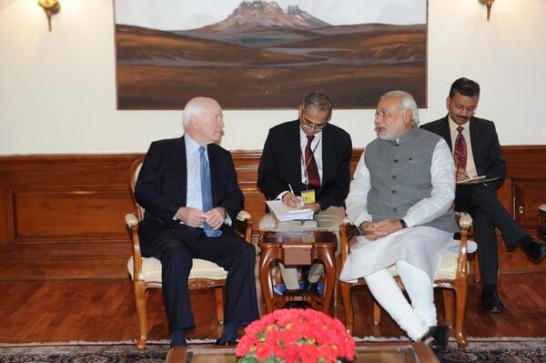 Image Courtesy Office of the Prime Minister of India
Image Courtesy Office of the Prime Minister of India
Two Critical Issues Facing the U.S.-India Relationship in 2014
India has been abuzz with the recent election victory of Narendra Modi. The former Chief Minister of the Indian state of Gujarat and member of the Bharatiya Janata Party (BJP) is renowned for the economic success that he led his state to in his 12 year-tenure as Chief Minister.
As Chief Minister of Gujarat, Mr. Modi had released a book titled “Convenient Action – Gujarat’s Response to Challenges of Climate Change.” In fact, this book lists the Narendra Modi-led Climate Change Department of Gujarat, which was established in 2009, and is noteworthy for being the sole Asian Climate Change Department belonging to the state of an Asian country.
Now that Mr. Modi is the Prime Minister of India, will there be greater focus by India on climate change and on trade ties with the U.S.? And is there a scope of advancements in Indo-U.S. relations by a focus on these issues?
Climate Change
Solar Energy
Addressing climate change requires that countries explore alternate sources of energy, such as solar power. Narendra Modi’s agenda involves generation of electricity by the provision of solar energy for the benefit of 400 million Indians. The Modi administration seeks to assist all homes with solar power so that they can operate “at least one light bulb by 2019.” Solar energy can help some Indian villages that are not connected to the grid by providing distributed energy.
Nuclear Energy
Nuclear energy in India could develop further under the Modi administration. The Ministry of External Affairs in India recently stated that India would allow the IAEA greater “oversight” of its “civilian nuclear program.” In fact, there is clear indication of Narendra Modi’s interest in working on Indian nuclear energy since he agreed to advance civilian-based “nuclear power projects” and enforce global “civil nuclear agreements.” However, India is facing obstacles from contractors who are hesitant to construct nuclear reactors, primarily because of the 2010 Indian law on “nuclear liability”, according to which contractors would have to dish out a heavy sum in case of any accident. Other countries that are heavily reliant on nuclear power do not have such a law.
Coal
India is heavily dependent on coal, and is only behind China and the United States in “global coal consumption.” However, an effort to explore cleaner forms of energy will likely develop India’s relationship with the Obama administration. President Obama has been an advocate for decreasing carbon emissions and has clearly articulated his belief that climate change is a threat. Exploration of renewable sources of energy by India such as solar power does not mean that it would give up on coal of immediately. Gradually decreasing dependency on coal over a steady timeframe as well as continuing exploration and utilization of solar and nuclear power will enable relations between India and the United States to improve.
Trade
What about the trade relationship between the two countries? India and the United States have lukewarm trade ties. In 2013, India constituted the “18th largest goods export market” for the United States and was the “10th largest supplier of goods imports.” Yet, disputes have overshadowed these statistics. Both Indian foreign direct investment (FDI) in the United States and American FDI in India rose from 2011 to 2012, by a margin of 6.7% in the former and 15.3% in the latter.
In fact, solar energy has been at the center of one of the disputes connecting the two countries. In February 2014, the United States threatened to “take India to the World Trade Organization” because of the “domestic content requirements in India’s massive solar program,” which U.S. Trade Representative Michael Froman believes inclines against American producers and can consequently hurt solar power proliferation. The two countries have had a troubled relationship because of the U.S. Trade Representative’s (USTR) warning of “trade sanctions” in reference to guarding of IPRs, or intellectual property rights.
However, the future may not look as bleak for India-U.S. trade relations under the administration of Narendra Modi. Prior to his victory in the national elections, Mr. Modi asserted that “It is in India’s interest to promote trade, commerce and technology. We will do whatever is necessary to that effect.” In fact, Congressman Ed Royce and Congressman George Holding want Mr. Modi to “address a joint meeting of Congress”, and they have justified this by providing examples of the relevance of India-U.S. relations, the number of Indians who voted in the 2014 elections, the economic success of Gujarat including the decline in poverty and improvement in infrastructure, and Mr. Modi’s plan to “focus on private enterprise, reduce bureaucracy, and strengthen trade ties with major partners.” In early July 2014, Senator John McCain visited Mr. Modi in New Delhi, days after he suggested to the Senate that the United States “should seek to help India’s economic and military development.”
Next Steps
The rise of Narendra Modi to the Indian leadership has the potential to change relations between India and the United States. While trade issues have plagued the relationship including the issue of solar requirements, it is likely that the positive strides being made by both the sides will gain greater momentum. Mr. Modi’s interest in advancing solar energy is likely to synchronize with the United States’ focus on tackling climate change. A focus on climate change and Indo-U.S. trade, along with ensuring a secure Asian region, the shared notions of democracy, and a new Indian government under Mr. Modi, are likely to open a new path for the India-U.S. relationship.






[…] Two Critical Issues Facing The U.S.-India Relationship in 2014Naman JainNow that Mr. Modi is the Prime Minister of India, will there be greater focus by India on climate change and on trade ties with the U.S.? And is there a scope of advancements in Indo-U.S. relations by a focus on these issues? […]